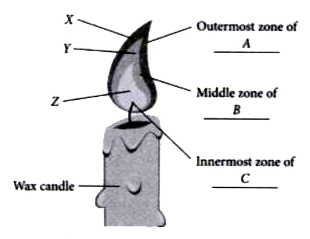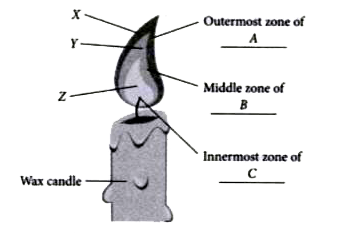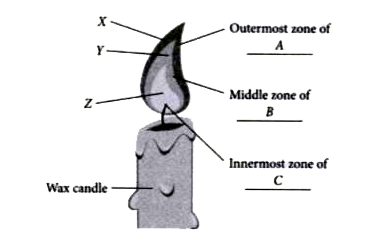The formation of soot particles during burning of a candle is due to
burning of hydrogen
unburnt carbon particles left behind because of insufficient oxygen for burning
burning of hydrocarbons
all of these.
The correct Answer is:B
To solve the question regarding the formation of soot particles during the burning of a candle, we can break it down into the following steps:
1. Understanding Combustion:
- When a candle burns, it undergoes a chemical reaction known as combustion. This process involves the candle wax (which is primarily made of hydrocarbons) reacting with oxygen in the air.
Hint: Recall that combustion is a reaction that typically requires oxygen.
2. Role of Oxygen:
- For complete combustion to occur, there must be a sufficient supply of oxygen. In complete combustion, hydrocarbons react with oxygen to produce carbon dioxide and water.
Hint: Think about what happens when there is enough oxygen for a reaction to proceed fully.
3. Insufficient Oxygen:
- If there is not enough oxygen available during the burning of the candle, the combustion process becomes incomplete. This means that not all of the carbon in the wax can convert to carbon dioxide.
Hint: Consider what might happen to the byproducts of combustion when oxygen levels are low.
4. Formation of Soot:
- The incomplete combustion of the hydrocarbons leads to the formation of soot, which consists of unburned carbon particles. These particles appear as black soot and are a result of the insufficient oxygen that prevents complete burning.
Hint: Remember that soot is a visible indication of incomplete combustion.
5. Conclusion:
- Therefore, the formation of soot particles during the burning of a candle is primarily due to the insufficient supply of oxygen, which leads to incomplete combustion of the candle wax.
Final Answer: The formation of soot particles during the burning of a candle is due to insufficient oxygen for complete combustion.
Summary:
The soot particles are formed because of incomplete combustion resulting from a lack of oxygen, leading to the presence of unburned carbon.
- When a candle burns, it undergoes a chemical reaction known as combustion. This process involves the candle wax (which is primarily made of hydrocarbons) reacting with oxygen in the air.
- For complete combustion to occur, there must be a sufficient supply of oxygen. In complete combustion, hydrocarbons react with oxygen to produce carbon dioxide and water.
- If there is not enough oxygen available during the burning of the candle, the combustion process becomes incomplete. This means that not all of the carbon in the wax can convert to carbon dioxide.
- The incomplete combustion of the hydrocarbons leads to the formation of soot, which consists of unburned carbon particles. These particles appear as black soot and are a result of the insufficient oxygen that prevents complete burning.
- Therefore, the formation of soot particles during the burning of a candle is primarily due to the insufficient supply of oxygen, which leads to incomplete combustion of the candle wax.
The soot particles are formed because of incomplete combustion resulting from a lack of oxygen, leading to the presence of unburned carbon.
Topper's Solved these Questions
- BOOK - MTG IIT JEE FOUNDATIONCHAPTER - FOOTSTEPS TOWARDS (JEE MAIN)EXERCISE - SECTION B (NUMBERIC VALUE TYPE QUESTIONS)10videos
FOOTSTEPS TOWARDS (JEE MAIN)
- BOOK - MTG IIT JEE FOUNDATIONCHAPTER - COMBUSTION AND FLAME EXERCISE - OLYMPIAD/HOTS CORNER15videos
COMBUSTION AND FLAME
- BOOK - MTG IIT JEE FOUNDATIONCHAPTER - FOOTSTEPS TOWARDS (NEET)EXERCISE - Multiple Choice Question45videos
FOOTSTEPS TOWARDS (NEET)
Similar Questions
Write more than one types of changes taking place during Burning of a candle
View SolutionTwo students A and B were asked to carry out one experiment. The smoke released due to the burning of a candle should be passed through lime water and anhydrous copper sulphate to prove the release of CO2 and H2O, respectively, due to the burning of the candle. A first passed the gases through lime water and then through copper sulphate, whereas B did it the other way round. The teacher commented that the set up used by A was wrong. What could be the reason for it?
View Solution
Knowledge Check
- Question 1 - Select One
The formation of soot occurs when
Athere is not enough oxygen for burning and few carbon particles are left unburntBthere is enough oxygen for burning carbon particlesCthere is not enough oxygen for burning hydrogenDnone of these. - Question 2 - Select One
In the above problem the acceleration of the rocket during burning interval is :
A(1200/12)m/s2B(12/1200)m/s2C(1200×12)m/s2D(1200/132)m/s2 - Question 3 - Select One
A flame is the visible gaseous part of a fire. It is a zone of combustion of gaseous substances accompanied by evolution of heat and light. All substances do not burn with a flame. Only those substances that vaporise during burning produce flame. A candle flame is taken to study the various zones of a flame.

Which zone of a candle flame is the zone of no combustion?AOutermost zoneBMiddle zoneCInnermost zoneDNone of these
Two students A and B were asked to carry out one experiment. The smoke released due to the burning of candle should be passed through lime water and anhydrous copper sulphate to prove the release of CO2andH2O respectively due to the burning of the candle. 'A' first passed the gases through lime water and then through copper sulphate whereas 'B' did it the other way round. The Teacher commented that the set up used by 'A' was wrong. What could be the reason for it?
View SolutionA flame is the visible gaseous part of a fire. It is a zone of combustion of gaseous substances accompanied by evolution of heat and light. All substances do not burn with a flame. Only those substances that vaporise during burning produce flame. A candle flame is taken to study the various zones of a flame.

(A), (B) and (C) are respectively.View SolutionA flame is the visible gaseous part of a fire. It is a zone of combustion of gaseous substances accompanied by evolution of heat and light. All substances do not burn with a flame. Only those substances that vaporise during burning produce flame. A candle flame is taken to study the various zones of a flame.

Arrange X, Y and Z in increasing order of temperature.View SolutionA flame is the visible gaseous part of a fire. It is a zone of combustion of gaseous substances accompanied by evolution of heat and light. All substances do not burn with a flame. Only those substances that vaporise during burning produce flame. A candle flame is taken to study the various zones of a flame.

The luminous and non-luminous zones of flame is respectively.View SolutionWhich of the following statements is correct for the process of burning of a candle?
View Solution

